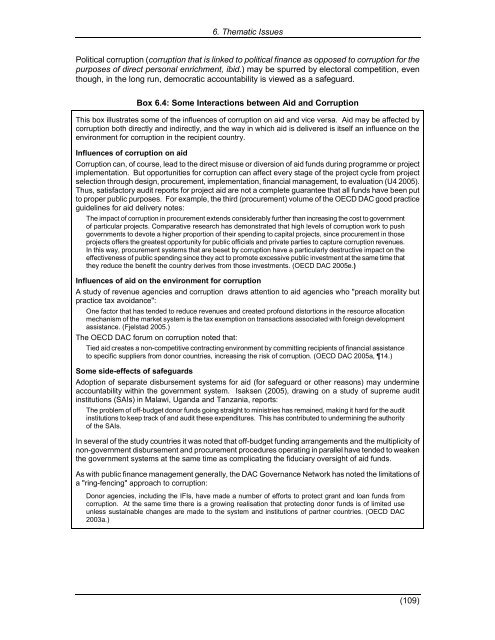Evaluation of General Budget Support: Synthesis Report - Belgium
Evaluation of General Budget Support: Synthesis Report - Belgium
Evaluation of General Budget Support: Synthesis Report - Belgium
You also want an ePaper? Increase the reach of your titles
YUMPU automatically turns print PDFs into web optimized ePapers that Google loves.
6. Thematic Issues<br />
Political corruption (corruption that is linked to political finance as opposed to corruption for the<br />
purposes <strong>of</strong> direct personal enrichment, ibid.) may be spurred by electoral competition, even<br />
though, in the long run, democratic accountability is viewed as a safeguard.<br />
Box 6.4: Some Interactions between Aid and Corruption<br />
This box illustrates some <strong>of</strong> the influences <strong>of</strong> corruption on aid and vice versa. Aid may be affected by<br />
corruption both directly and indirectly, and the way in which aid is delivered is itself an influence on the<br />
environment for corruption in the recipient country.<br />
Influences <strong>of</strong> corruption on aid<br />
Corruption can, <strong>of</strong> course, lead to the direct misuse or diversion <strong>of</strong> aid funds during programme or project<br />
implementation. But opportunities for corruption can affect every stage <strong>of</strong> the project cycle from project<br />
selection through design, procurement, implementation, financial management, to evaluation (U4 2005).<br />
Thus, satisfactory audit reports for project aid are not a complete guarantee that all funds have been put<br />
to proper public purposes. For example, the third (procurement) volume <strong>of</strong> the OECD DAC good practice<br />
guidelines for aid delivery notes:<br />
The impact <strong>of</strong> corruption in procurement extends considerably further than increasing the cost to government<br />
<strong>of</strong> particular projects. Comparative research has demonstrated that high levels <strong>of</strong> corruption work to push<br />
governments to devote a higher proportion <strong>of</strong> their spending to capital projects, since procurement in those<br />
projects <strong>of</strong>fers the greatest opportunity for public <strong>of</strong>ficials and private parties to capture corruption revenues.<br />
In this way, procurement systems that are beset by corruption have a particularly destructive impact on the<br />
effectiveness <strong>of</strong> public spending since they act to promote excessive public investment at the same time that<br />
they reduce the benefit the country derives from those investments. (OECD DAC 2005e.)<br />
Influences <strong>of</strong> aid on the environment for corruption<br />
A study <strong>of</strong> revenue agencies and corruption draws attention to aid agencies who "preach morality but<br />
practice tax avoidance":<br />
One factor that has tended to reduce revenues and created pr<strong>of</strong>ound distortions in the resource allocation<br />
mechanism <strong>of</strong> the market system is the tax exemption on transactions associated with foreign development<br />
assistance. (Fjelstad 2005.)<br />
The OECD DAC forum on corruption noted that:<br />
Tied aid creates a non-competitive contracting environment by committing recipients <strong>of</strong> financial assistance<br />
to specific suppliers from donor countries, increasing the risk <strong>of</strong> corruption. (OECD DAC 2005a, 14.)<br />
Some side-effects <strong>of</strong> safeguards<br />
Adoption <strong>of</strong> separate disbursement systems for aid (for safeguard or other reasons) may undermine<br />
accountability within the government system. Isaksen (2005), drawing on a study <strong>of</strong> supreme audit<br />
institutions (SAIs) in Malawi, Uganda and Tanzania, reports:<br />
The problem <strong>of</strong> <strong>of</strong>f-budget donor funds going straight to ministries has remained, making it hard for the audit<br />
institutions to keep track <strong>of</strong> and audit these expenditures. This has contributed to undermining the authority<br />
<strong>of</strong> the SAIs.<br />
In several <strong>of</strong> the study countries it was noted that <strong>of</strong>f-budget funding arrangements and the multiplicity <strong>of</strong><br />
non-government disbursement and procurement procedures operating in parallel have tended to weaken<br />
the government systems at the same time as complicating the fiduciary oversight <strong>of</strong> aid funds.<br />
As with public finance management generally, the DAC Governance Network has noted the limitations <strong>of</strong><br />
a "ring-fencing" approach to corruption:<br />
Donor agencies, including the IFIs, have made a number <strong>of</strong> efforts to protect grant and loan funds from<br />
corruption. At the same time there is a growing realisation that protecting donor funds is <strong>of</strong> limited use<br />
unless sustainable changes are made to the system and institutions <strong>of</strong> partner countries. (OECD DAC<br />
2003a.)<br />
(109)

















